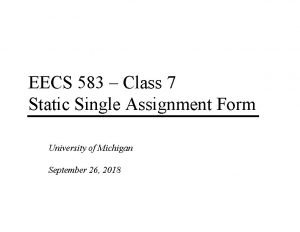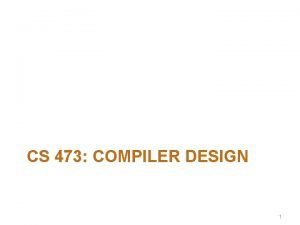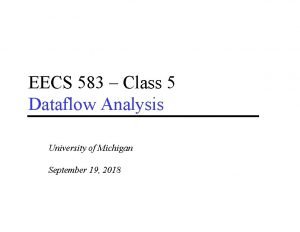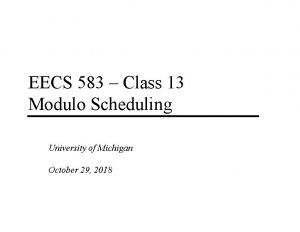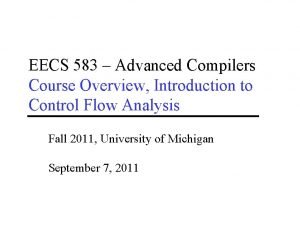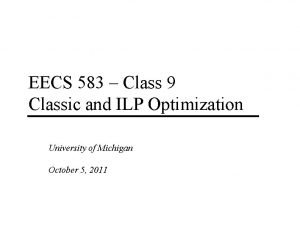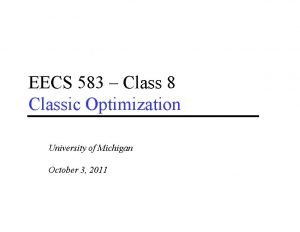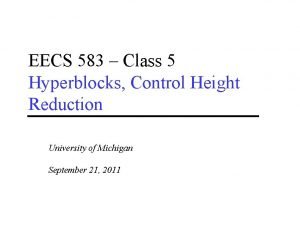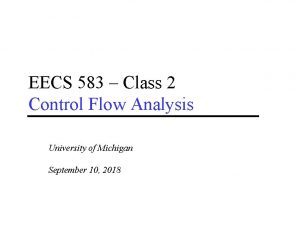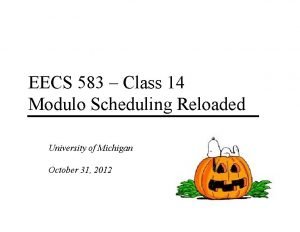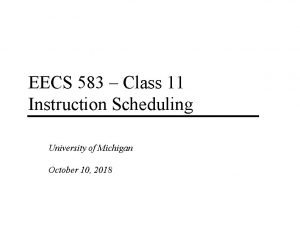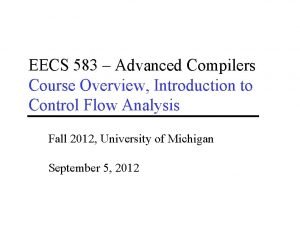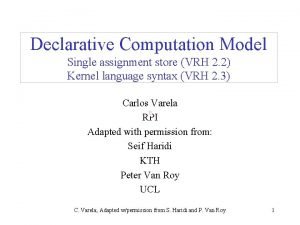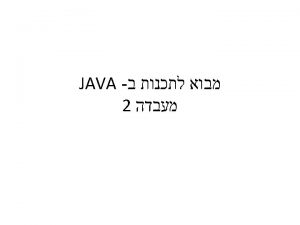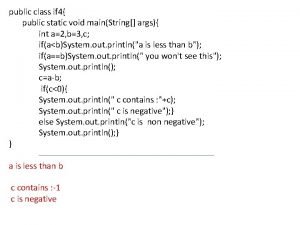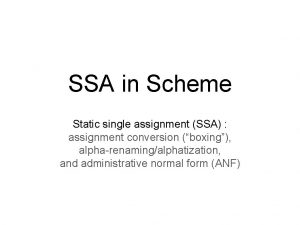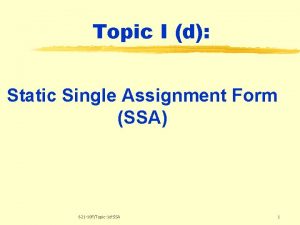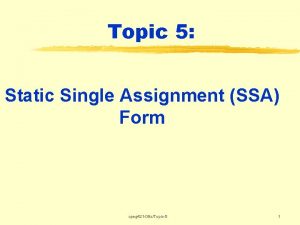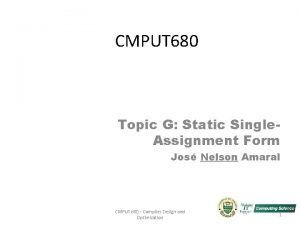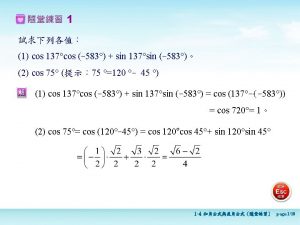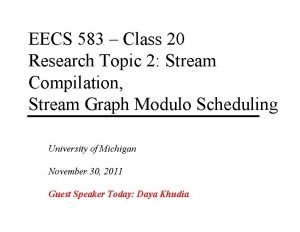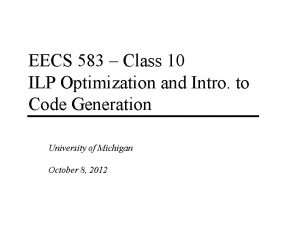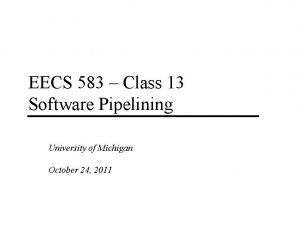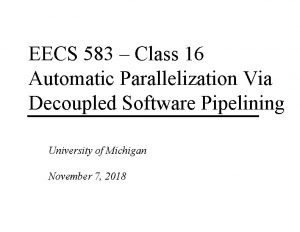EECS 583 Class 7 Static Single Assignment Form






























- Slides: 30

EECS 583 – Class 7 Static Single Assignment Form University of Michigan September 26, 2018

Announcements & Reading Material v HW 2 is out – Available on course webpage » See piazza for guide/hints » Benchmarks will be posted soon, but you can start w/o them! v Today’s class » “Practical Improvements to the Construction and Destruction of Static Single Assignment Form, ” P. Briggs, K. Cooper, T. Harvey, and L. Simpson, Software--Practice and Experience, 28(8), July 1998, pp. 859 -891. v Next class – Optimization » Compilers: Principles, Techniques, and Tools, A. Aho, R. Sethi, and J. Ullman, Addison-Wesley, 1988, 9. 9, 10. 2, 10. 3, 10. 7 Edition 1; 8. 5, 8. 7, 9. 1, 9. 4, 9. 5 Edition 2 -1 -

Homework 2 – Frequent Path LICM j = 99; for (i=0; i<100; i++) { B[i] = A[j] * 23 + i; if (i % 32 == 0) j = i; /* infrequent */ } j = 99; t = j; for (i=0; i<100; i++) { B[i] = A[t] * 23 + i; if (i % 32 == 0) j = i; /* infrequent */ } Basic j = 99; t = j; for (i=0; i<100; i++) { B[i] = A[t] * 23 + i; if (i % 32 == 0) { j = i; /* infrequent */ Insert t = j; /* fixup */ repair code } } j = 99; t = A[j] * 23; for (i=0; i<100; i++) { B[i] = t + i; if (i % 32 == 0) { j = i; /* infrequent */ Bonus, t = A[j] * 23; /* fixup */ Hoist invariant uses, } update repair code } -2 -

Dataflow Analyses in 1 Slide Liveness Reaching Definitions/DU/UD OUT = Union(IN(succs)) IN = GEN + (OUT – KILL) IN = Union(OUT(preds)) OUT = GEN + (IN – KILL) Bottom-up dataflow Any path Keep track of variables/registers Uses of variables GEN Defs of variables KILL Top-down dataflow Any path Keep track of instruction IDs Defs of variables GEN Defs of variables KILL Available Expressions Available Definitions IN = Intersect(OUT(preds)) OUT = GEN + (IN – KILL) Top-down dataflow All path Keep track of instruction IDs Expressions of variables GEN Defs of variables KILL Top-down dataflow All path Keep track of instruction IDs Defs of variables GEN Defs of variables KILL -3 -

Some Things to Think About v Liveness and rdefs are basically the same thing » All dataflow is basically the same with a few parameters Ÿ Ÿ v Meaning of gen/kill – src vs dest, variable vs operation Backward / Forward All paths / some paths (must/may) What other dataflow analysis problems can be formulated? Dataflow can be slow » How to implement it efficiently? Ÿ Forward analysis – DFS order Ÿ Backward analysis – Post. DFS order » How to represent the info? v Predicates » Throw a monkey wrench into this stuff » So, how are predicates handled? -4 -

Static Single Assignment (SSA) Form v Difficulty with optimization » Multiple definitions of the same register » Which definition reaches » Is expression available? v r 1 = r 2 + r 3 r 6 = r 4 – r 5 r 4 = r 6 = 8 r 7 = r 1 + r 6 r 8 = r 2 + r 3 Static single assignment » Each assignment to a variable is given a unique name » All of the uses reached by that assignment are renamed » DU chains become obvious based on the register name! -5 -

Converting to SSA Form v Trivial for straight line code x = -1 y=x x=5 z=x v x 0 = -1 y = x 0 x 1 = 5 z = x 1 More complex with control flow – Must use Phi nodes if (. . . ) x 0 = -1 else x 1 = 5 x 2 = Phi(x 0, x 1) y = x 2 if (. . . ) x = -1 else x=5 y=x -6 -

Converting to SSA Form (2) v What about loops? » No problem!, use Phi nodes again i 0 = 0 do { i 1 = Phi(i 0, i 2) i 2 = i 1 + 1 } while (i 2 < 50) i=0 do { i=i+1 } while (i < 50) -7 -

SSA Plusses and Minuses v Advantages of SSA » Explicit DU chains – Trivial to figure out what defs reach a use Ÿ Each use has exactly 1 definition!!! » Explicit merging of values » Makes optimizations easier v Disadvantages » When transform the code, must either recompute (slow) or incrementally update (tedious) -8 -

Phi Nodes (aka Phi Functions) v v Special kind of copy that selects one of its inputs Choice of input is governed by the CFG edge along which control flow reached the Phi node x 0 = x 1 = x 2 = Phi(x 0, x 1) v Phi nodes are required when 2 non-null paths X Z and Y Z converge at node Z, and nodes X and Y contain assignments to V -9 -

SSA Construction v High-level algorithm 1. Insert Phi nodes 2. Rename variables v A dumb algorithm » Insert Phi functions at every join for every variable » Solve reaching definitions » Rename each use to the def that reaches it (will be unique) v Problems with the dumb algorithm » Too many Phi functions (precision) » Too many Phi functions (space) » Too many Phi functions (time) - 10 -

Need Better Phi Node Insertion Algorithm v A definition at n forces a Phi node at m iff n not in DOM(m), but n in DOM(p) for some predecessors p of m BB 0 def in BB 4 forces Phi in BB 6 def in BB 6 forces Phi in BB 7 def in BB 7 forces Phi in BB 1 BB 2 BB 3 BB 4 Phi is placed in the block that is just outside the dominated region of the definition BB BB 5 Dominance frontier The dominance frontier of node X is the set of nodes Y such that * X dominates a predecessor of Y, but * X does not strictly dominate Y BB 6 BB 7 - 11 -

Recall: Dominator Tree BB 0 1 2 3 First BB is the root node, each node dominates all of its descendants BB 0 DOM 0 0, 1, 2 0, 1, 3 BB 1 BB 2 BB 4 5 6 7 BB 0 BB 3 BB 1 BB 2 BB 4 BB 3 BB 5 BB 4 BB 6 BB 7 BB 5 BB 6 BB 7 Dom tree - 12 - DOM 0, 1, 3, 4 0, 1, 3, 5 0, 1, 3, 6 0, 1, 7

Computing Dominance Frontiers BB 0 BB 1 BB 2 BB 3 BB 4 BB 5 BB 6 BB 7 BB 5 BB 6 BB 0 1 2 3 4 5 6 7 DF BB 7 For each join point X in the CFG For each predecessor, Y, of X in the CFG Run up to the IDOM(X) in the dominator tree, adding X to DF(N) for each N between Y and IDOM(X) (or X, whichever is encountered first) - 13 -

Class Problem Compute dominance frontiers for each BB BB 0 a= b= c= Dominator Tree BB 0 BB 1 BB 2 c=b+a BB 4 b=c-a BB 5 BB 3 a=a-c c=b*c b=a+1 a=b*c BB 2 BB 3 BB 4 BB 5 For each join point X in the CFG For each predecessor, Y, of X in the CFG Run up to the IDOM(X) in the dominator tree, adding X to DF(N) for each N between Y and IDOM(X) (or X, whichever is encountered first) - 14 -

SSA Step 1 - Phi Node Insertion v v Compute dominance frontiers Find global names (aka virtual registers) » Global if name live on entry to some block » For each name, build a list of blocks that define it v Insert Phi nodes » For each global name n Ÿ For each BB b in which n is defined u For each BB d in b’s dominance frontier o Insert a Phi node for n in d o Add d to n’s list of defining BBs - 15 -

Phi Node Insertion - Example BB 0 1 2 3 4 5 6 7 DF 7 7 6 6 7 1 BB 0 BB 1 BB 2 b= c= d= a= b= c= i= a = Phi(a, a) b = Phi(b, b) c = Phi(c, c) d = Phi(d, d) i = Phi(i, i) a= c= BB 3 BB 4 d= BB 6 BB 7 i= a= d= BB 5 c= c = Phi(c, c) d = Phi(d, d) b= a = Phi(a, a) b = Phi(b, b) c = Phi(c, c) d = Phi(d, d) - 16 - a is defined in 0, 1, 3 need Phi in 7 then a is defined in 7 need Phi in 1 b is defined in 0, 2, 6 need Phi in 7 then b is defined in 7 need Phi in 1 c is defined in 0, 1, 2, 5 need Phi in 6, 7 then c is defined in 7 need Phi in 1 d is defined in 2, 3, 4 need Phi in 6, 7 then d is defined in 7 need Phi in 1 i is defined in BB 7 need Phi in BB 1

Class Problem Insert the Phi nodes BB 0 Dominance frontier Dominator tree a= b= c= BB 0 BB 1 BB 2 c=b+a BB 4 b=c-a BB 5 BB 2 BB 3 b=a+1 a=b*c a=a-c c=b*c - 17 - BB 3 BB 4 BB 5 BB 0 1 2 3 4 5 DF 4 4, 5 5 1

SSA Step 2 – Renaming Variables v v Use an array of stacks, one stack per global variable (VR) Algorithm sketch » For each BB b in a preorder traversal of the dominator tree Ÿ Generate unique names for each Phi node Ÿ Rewrite each operation in the BB u u Uses of global name: current name from stack Defs of global name: create and push new name Ÿ Fill in Phi node parameters of successor blocks Ÿ Recurse on b’s children in the dominator tree Ÿ <on exit from b> pop names generated in b from stacks - 18 -

Renaming – Example (Initial State) BB 0 BB 1 BB 2 b= c= d= a= b= c= i= a = Phi(a, a) b = Phi(b, b) c = Phi(c, c) d = Phi(d, d) i = Phi(i, i) a= c= BB 3 BB 4 d= BB 6 BB 7 i= BB 1 BB 2 BB 3 BB 4 BB 5 BB 6 a= d= BB 5 BB 7 c= c = Phi(c, c) d = Phi(d, d) b= a = Phi(a, a) b = Phi(b, b) c = Phi(c, c) d = Phi(d, d) - 19 - var: a b c d i ctr: 0 0 0 stk: a 0 b 0 c 0 d 0 i 0

Renaming – Example (After BB 0) BB 0 BB 1 BB 2 b= c= d= a 0 = b 0 = c 0 = i 0 = a = Phi(a 0, a) b = Phi(b 0, b) c = Phi(c 0, c) d = Phi(d 0, d) i = Phi(i 0, i) a= c= d= BB 6 BB 7 i= BB 2 BB 3 BB 4 BB 1 a= d= BB 5 BB 7 c= c = Phi(c, c) d = Phi(d, d) b= a = Phi(a, a) b = Phi(b, b) c = Phi(c, c) d = Phi(d, d) - 20 - BB 5 BB 6 var: a b c d i ctr: 1 1 1 stk: a 0 b 0 c 0 d 0 i 0

Renaming – Example (After BB 1) BB 0 BB 1 BB 2 b= c= d= a 0 = b 0 = c 0 = i 0 = a 1 = Phi(a 0, a) b 1 = Phi(b 0, b) c 1 = Phi(c 0, c) d 1 = Phi(d 0, d) i 1 = Phi(i 0, i) a 2 = c 2 = d= BB 6 BB 7 i= BB 2 BB 3 BB 4 BB 1 a= d= BB 5 BB 7 c= c = Phi(c, c) d = Phi(d, d) b= a = Phi(a, a) b = Phi(b, b) c = Phi(c, c) d = Phi(d, d) - 21 - BB 5 BB 6 var: a ctr: 3 stk: a 0 a 1 a 2 b 0 b 1 c 3 c 0 c 1 c 2 d 0 d 1 i 2 i 0 i 1

Renaming – Example (After BB 2) BB 0 BB 1 BB 2 b 2 = c 3 = d 2 = a 0 = b 0 = c 0 = i 0 = a 1 = Phi(a 0, a) b 1 = Phi(b 0, b) c 1 = Phi(c 0, c) d 1 = Phi(d 0, d) i 1 = Phi(i 0, i) a 2 = c 2 = d= BB 6 BB 7 i= BB 2 BB 3 BB 4 BB 1 a= d= BB 5 BB 7 c= c = Phi(c, c) d = Phi(d, d) b= a = Phi(a 2, a) b = Phi(b 2, b) c = Phi(c 3, c) d = Phi(d 2, d) - 22 - BB 5 BB 6 var: a ctr: 3 stk: a 0 a 1 a 2 b 3 b 0 b 1 b 2 c d 4 3 c 0 d 0 c 1 d 1 c 2 d 2 c 3 i 2 i 0 i 1

Renaming – Example (Before BB 3) This just updates the stack to remove the stuff from the left path BB 0 out of BB 1 BB 2 b 2 = c 3 = d 2 = BB 0 a 0 = b 0 = c 0 = i 0 = a 1 = Phi(a 0, a) b 1 = Phi(b 0, b) c 1 = Phi(c 0, c) d 1 = Phi(d 0, d) i 1 = Phi(i 0, i) a 2 = c 2 = d= BB 6 BB 7 i= BB 2 BB 3 BB 4 BB 1 a= d= BB 5 BB 7 c= c = Phi(c, c) d = Phi(d, d) b= a = Phi(a 2, a) b = Phi(b 2, b) c = Phi(c 3, c) d = Phi(d 2, d) - 23 - BB 5 BB 6 var: a ctr: 3 stk: a 0 a 1 a 2 b 3 b 0 b 1 c 4 c 0 c 1 c 2 d 3 d 0 d 1 i 2 i 0 i 1

Renaming – Example (After BB 3) BB 0 BB 1 BB 2 b 2 = c 3 = d 2 = a 0 = b 0 = c 0 = i 0 = a 1 = Phi(a 0, a) b 1 = Phi(b 0, b) c 1 = Phi(c 0, c) d 1 = Phi(d 0, d) i 1 = Phi(i 0, i) a 2 = c 2 = d= BB 6 BB 7 i= BB 2 BB 3 BB 4 BB 1 a 3 = d 3 = BB 5 BB 7 c= c = Phi(c, c) d = Phi(d, d) b= a = Phi(a 2, a) b = Phi(b 2, b) c = Phi(c 3, c) d = Phi(d 2, d) - 24 - BB 5 BB 6 var: a ctr: 4 stk: a 0 a 1 a 2 a 3 b 0 b 1 c 4 c 0 c 1 c 2 d 4 d 0 d 1 d 3 i 2 i 0 i 1

Renaming – Example (After BB 4) BB 0 BB 1 BB 2 b 2 = c 3 = d 2 = a 0 = b 0 = c 0 = i 0 = a 1 = Phi(a 0, a) b 1 = Phi(b 0, b) c 1 = Phi(c 0, c) d 1 = Phi(d 0, d) i 1 = Phi(i 0, i) a 2 = c 2 = d 4 = BB 6 BB 7 i= BB 2 BB 3 BB 4 BB 1 a 3 = d 3 = BB 5 BB 7 c= c = Phi(c 2, c) d = Phi(d 4, d) b= a = Phi(a 2, a) b = Phi(b 2, b) c = Phi(c 3, c) d = Phi(d 2, d) - 25 - BB 5 BB 6 var: a ctr: 4 stk: a 0 a 1 a 2 a 3 b 0 b 1 c 4 c 0 c 1 c 2 d 5 d 0 d 1 d 3 d 4 i 2 i 0 i 1

Renaming – Example (After BB 5) BB 0 BB 1 BB 2 b 2 = c 3 = d 2 = a 0 = b 0 = c 0 = i 0 = a 1 = Phi(a 0, a) b 1 = Phi(b 0, b) c 1 = Phi(c 0, c) d 1 = Phi(d 0, d) i 1 = Phi(i 0, i) a 2 = c 2 = d 4 = BB 6 BB 7 i= BB 2 BB 3 BB 4 BB 1 a 3 = d 3 = BB 5 BB 7 c 4 = c = Phi(c 2, c 4) d = Phi(d 4, d 3) b= a = Phi(a 2, a) b = Phi(b 2, b) c = Phi(c 3, c) d = Phi(d 2, d) - 26 - BB 5 BB 6 var: a ctr: 4 stk: a 0 a 1 a 2 a 3 b 0 b 1 c 5 c 0 c 1 c 2 c 4 d 5 d 0 d 1 d 3 i 2 i 0 i 1

Renaming – Example (After BB 6) BB 0 BB 1 BB 2 b 2 = c 3 = d 2 = a 0 = b 0 = c 0 = i 0 = a 1 = Phi(a 0, a) b 1 = Phi(b 0, b) c 1 = Phi(c 0, c) d 1 = Phi(d 0, d) i 1 = Phi(i 0, i) a 2 = c 2 = d 4 = BB 6 BB 7 i= BB 2 BB 3 BB 4 BB 1 a 3 = d 3 = BB 5 BB 7 c 4 = c 5 = Phi(c 2, c 4) d 5 = Phi(d 4, d 3) b 3 = a = Phi(a 2, a 3) b = Phi(b 2, b 3) c = Phi(c 3, c 5) d = Phi(d 2, d 5) - 27 - BB 5 BB 6 var: a ctr: 4 stk: a 0 a 1 a 2 a 3 b 4 b 0 b 1 b 3 c 6 c 0 c 1 c 2 c 5 d 6 d 0 d 1 d 3 d 5 i 2 i 0 i 1

Renaming – Example (After BB 7) BB 0 BB 1 BB 2 b 2 = c 3 = d 2 = a 0 = b 0 = c 0 = i 0 = a 1 = Phi(a 0, a 4) b 1 = Phi(b 0, b 4) c 1 = Phi(c 0, c 6) d 1 = Phi(d 0, d 6) i 1 = Phi(i 0, i 2) a 2 = c 2 = d 4 = BB 6 BB 7 i 2 = BB 2 BB 3 BB 4 BB 1 a 3 = d 3 = BB 5 BB 7 c 4 = c 5 = Phi(c 2, c 4) d 5 = Phi(d 4, d 3) b 3 = a 4 = Phi(a 2, a 3) b 4 = Phi(b 2, b 3) c 6 = Phi(c 3, c 5) d 6 = Phi(d 2, d 5) - 28 - BB 5 BB 6 var: a ctr: 5 stk: a 0 a 1 a 2 a 4 b 5 b 0 b 1 b 4 c 7 c 0 c 1 c 2 c 6 d 7 d 0 d 1 d 6 i 3 i 0 i 1 i 2 Fin!

Class Problem Rename the variables BB 0 Dominance frontier a= b= c= a = Phi(a, a) b = Phi(b, b) c = Phi(c, c) BB 1 a = Phi(a, a) BB 2 b = Phi(b, b) c = Phi(c, c) BB 4 c=b+a BB 3 b=a+1 a=b*c b=c-a BB 5 a=a-c c=b*c a = Phi(a, a) b = Phi(b, b) c = Phi(c, c) - 29 - BB 0 1 2 3 4 5 DF 4 4, 5 5 1
 Static single assignment form in compiler design
Static single assignment form in compiler design Eecs583
Eecs583 Single static assignment
Single static assignment Eecs 583
Eecs 583 Mii umich
Mii umich Eecs583
Eecs583 Eecs583
Eecs583 Eecs 583
Eecs 583 Eecs 583
Eecs 583 Eecs 583
Eecs 583 Mrt step 7
Mrt step 7 Eecs 583
Eecs 583 Eecs583
Eecs583 Static single assignment
Static single assignment Static and dynamic class loading in java
Static and dynamic class loading in java Analysis level class diagram
Analysis level class diagram Resolución 583 de 2018
Resolución 583 de 2018 Morphological operations in image processing
Morphological operations in image processing Cs 583
Cs 583 Seo931
Seo931 583 frum
583 frum Seo931
Seo931 Cs 583
Cs 583 Cs 583
Cs 583 Sisd simd misd mimd examples
Sisd simd misd mimd examples Dataxin
Dataxin Waiting line management
Waiting line management Welcome to another week
Welcome to another week Secret class87
Secret class87 Class operators public static void main
Class operators public static void main Public class prg public static void main
Public class prg public static void main

